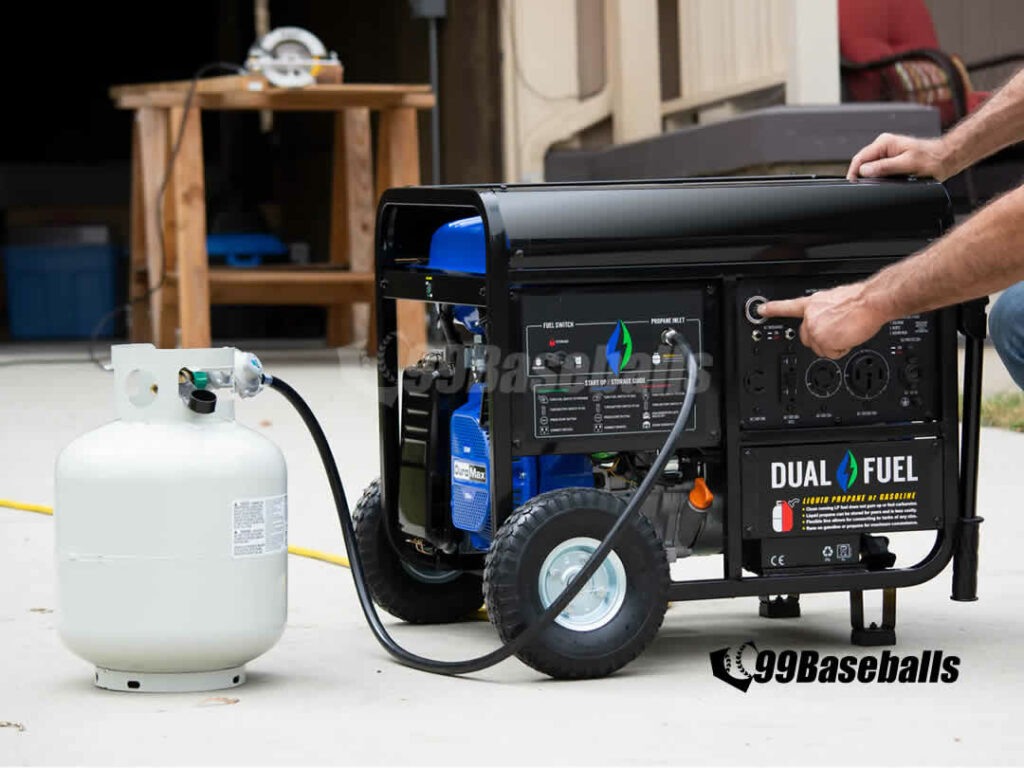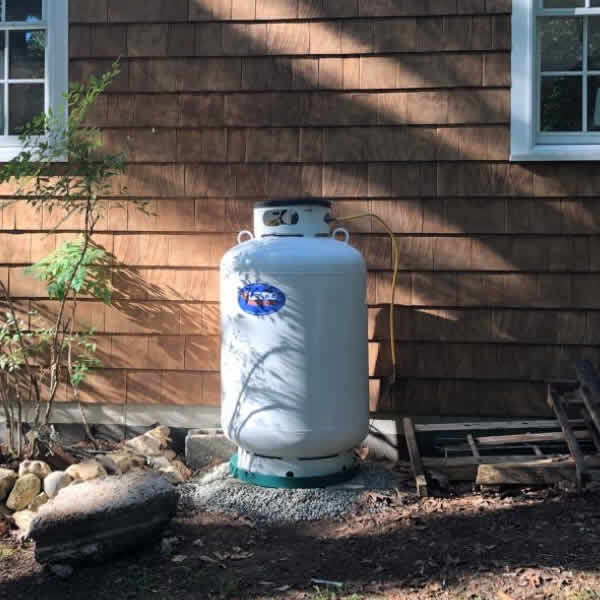Key Points
- Propane tank should be placed on the opposite side of the exhaust pipe
- Although there is no rule about the length of propane hose, it should be shorter than 20 feet
Table of Contents
Introduction
Propane (sometimes referred to as liquified petroleum gas or LPG) is a colorless and odorless gas that is stored in liquid state inside a propane tank.
It is now common to see a generator that can use both gasoline or propane (“duel fuel”) as a fuel source because propane gives a user another fuel choice to generate electricity during emergency.
Unlike gasoline, which starts to degrades as soon as 30 days of being made, propane can be stored indefinitely.
Although propane is clean burning and affordable, it is heavier than air so propane tanks must be stored far away from sleeping areas.
Propane Tanks – Filling Capacity
- One gallon of propane weighs approximately 4.2 pounds
- An empty 20lb propane tank (BBQ grill variety) weighs approximately 17 pounds
- Most refilling stations will fill up to 80% tank capacity
- A “full” 20lb propane tank should weight approximately 32 pounds
- Remember that propane is consumed as gas, not liquid
| Propane Tank Capacity | Filled Capacity |
| 20 pounds | 16 pounds (~3.8 gallons) |
| 40 pounds | 32 pounds (~7.6 gallons) |
| 50 pounds | 40 pounds (~9.5 gallons) |
| 75 pounds | 60 pounds (~14 gallons) |
| 100 pounds | 80 pounds (~19 gallons) |
Propane Tanks – Certifications
- All propane tanks in the US have a manufacturing month and year stamped on the collar
- For 20lb propane tanks have 12 years from the original manufacture date before it must be re-certified
- Re-certification adds 5 extra years and a new date is stamped on the collar
- Most older tanks are scrapped rather than re-certified
- Most propane refilling stations will NOT refill a tank that is “expired”
- If you have expired propane tanks, you can always pay bit extra for a tank exchange program at a home improvement store (Blue Rhinos)
- Brand new tanks must be purged of air (most refilling stations will do this for free when refilling at the same time)
Point of Transfer – Distance Requirements
- According to NFPA (National Fire Protection Association), a point-of-transfer is defined as “the location where connections and disconnections are made where propane is vented to the atmosphere in the course of transfer operations”
- In the case of propane tank attached to a portable generator, the minimum distance is 5 feet
- All modern propane tanks come with pressure-relief valves thus tanks must be located away from potential sources of ignition
- Propane tank supply the portable generator should be placed on the opposite side of the generator’s exhaust pipe (in a case of extreme cold, I would place the tank on the same side as the exhaust pipe to warm up the tank)
Long Propane Hose – Maximum Length of a Propane Hose
- There is no US legal limit on the maximum length of a propane hose
- In residential setting, most limit the propane hose length to 20 feet
- Longer hoses, depending on its diameter, may restrict the gas flow
- The length of a propane hose is inversely related to propane gas pressure (i.e. longer the hose will result in lower gas pressure)
Takeaways
- Although a propane hose can be extended by joining two shorter hoses together, it is preferable to use a once-piece hose
- Using a longer hose when your generator is running at max load means your generator may not get sufficient fuel for continued operation
Frequently Asked Questions
- Does propane go bad or expire?
- No, unlike gasoline, propane does not degrade over time and can even be used after 30 years if stored properly
- How do I save money on propane?
- If possible, refill your portable propane tanks at a local tool rental stores or wholesale stores like BJ’s rather than from a home improvement box stores. As of October 2022, it costs $16 (in the northeast) to refill a 20lb tank. The same sized tank at a home improvement store (i.e. Blue Rhino tank swapping) will cost $30
Reference Links
- What size propane tank do you need? (AmeriGas)
- How to Properly Store Flammable Fuel
- What Fuel is Best for Small Engines
- Complete Troubleshooting Guide for Caterpillar RP7500E Portable Generators (AllThumbsDIY)
- Detailed Parts List for Caterpillar RP7500E Generator (AllThumbsDIY)
- Connecting a Portable Generator to the Home Main Electric Panel – Part 1
- Caterpillar CAT7500E Support Page (cat.com)
- Buying a Portable Generator Shed – Lifetime Horizontal Shed
- Building a Custom Portable Generator Shed
- Engine Tune up for Generac Wheelhouse 5500 / 5550 Portable Generator
- Fast and Easy Fix for Your Generac Wheelhouse 5500 / 5550 Portable Generator – Part 1
- Fast and Easy Fix for Your Generac Wheelhouse 5500 / 5550 Portable Generator – Part 2
- Make Your Own Carburetor Gasket and Save Money
- Review – Neiko 10070A Torx Bit and External Torx Socket 35-piece Set
- Need a new generator? Consider DuroMax XP13000EH





